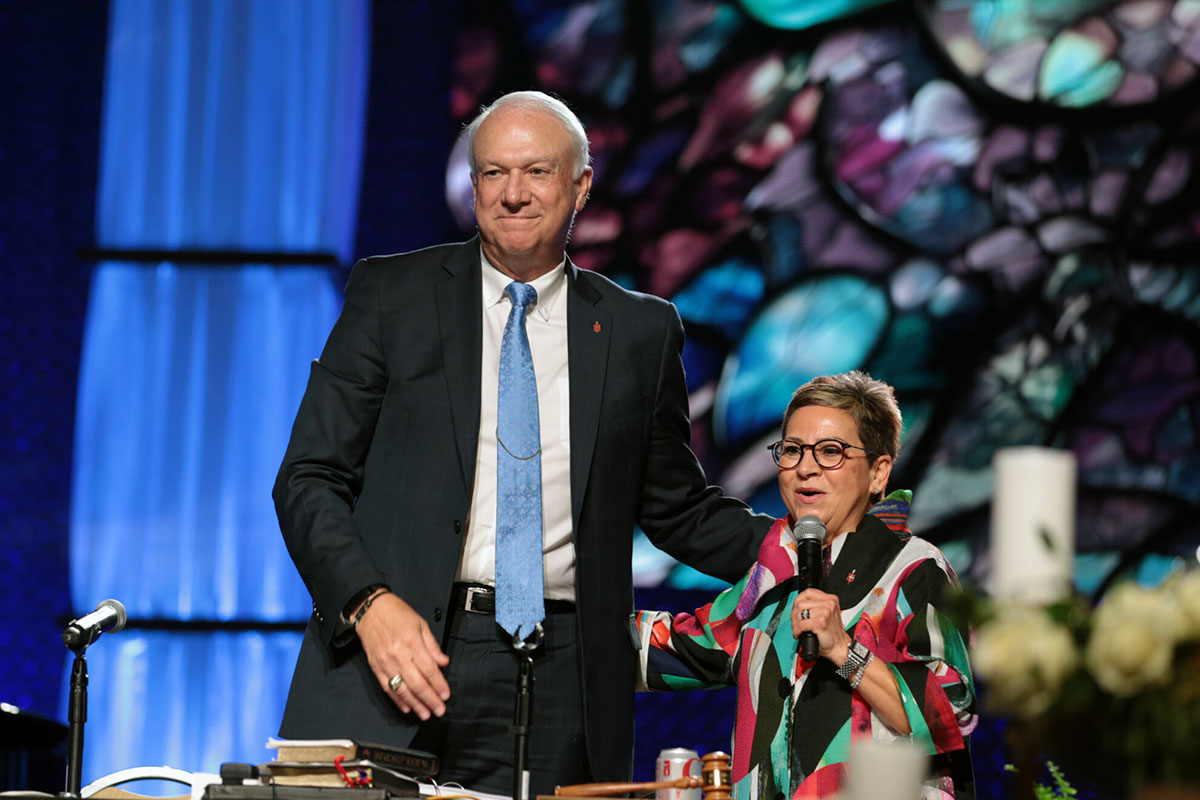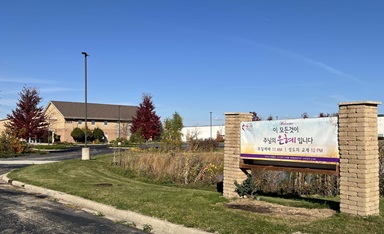주요 포인트:
- 교회의 재산을 소유한 교회가 교단을 탈퇴할 수 있도록 허용하는 교회법이 발효된 이후 미국 교회의 약 20%가 연합감리교회를 떠났다.
- 이는 미국 연합감리교회의 약 80%가 남아있다는 것을 의미한다.
- 미국의 많은 연회가 지금을 기존 교회와 새롭게 개척하는 교회 모두 성장할 기회로 여긴다.
미국의 많은 연합감리교인에게 익숙한 연회 개회 찬송가 "생전에 우리가(통일찬송가 280장)"는 올해 연회에 참석한 사람들을 울컥하게 만들었다.
연합감리교회의 지역 단위인 연회들이 미국 내 교회들의 교단 탈퇴를 승인하고, 그들을 떠나보내야 하는 가슴 아픈 시기를 거쳤기 때문이다. 따라서 헌신적인 연합감리교인들에겐 여전히 "생전에 우리가 또다시 모였네… 그 은혜 찬송하려고 이곳에 모였네"라는 찰스 웨슬리가 작시한 찬송을 힘차게 노래할 충분한 이유가 있었다.
미국의 다른 주요 개신교 교단들이 이전에 겪었던 것과 같이, 연합감리교회도 교회 내 성소수자의 역할에 대한 수십 년간의 내부 갈등 끝에 분열을 경험하고 있다.
 루이스교회리더십센터(Lewis Center for Church Leadership)가 제공한 연합감리교회의 지역적 분포와 교단 탈퇴의 지역적 분포를 비교한 그래프.미 북부 지역에 속한 지역총회는 소속된 교회 비율보다 적은 교회들이 교단을 떠났고, 남부의 경우에는 반대로 소속된 교회 비율보다 교단을 떠난 교회의 비율이 높다. 이 그래프는 루이스센터가 만든 그래프를 한국어로 변역한 것이다. 제공, 루이스교회리더십센터.
루이스교회리더십센터(Lewis Center for Church Leadership)가 제공한 연합감리교회의 지역적 분포와 교단 탈퇴의 지역적 분포를 비교한 그래프.미 북부 지역에 속한 지역총회는 소속된 교회 비율보다 적은 교회들이 교단을 떠났고, 남부의 경우에는 반대로 소속된 교회 비율보다 교단을 떠난 교회의 비율이 높다. 이 그래프는 루이스센터가 만든 그래프를 한국어로 변역한 것이다. 제공, 루이스교회리더십센터.
하지만 5월과 6월에 열린 많은 미국의 연회들은 교단 탈퇴로 인한 이별의 슬픔 속에서도, 새로운 연합감리교회 신앙 공동체를 환영하며, 교회의 울타리를 넘어 그리스도의 은혜와 복음을 전하겠다는 결단의 갱신을 함께 감사했다.
뉴욕 연회를 이끄는 토마스 J. 비커튼 감독회장은 텍사스 연회에 참석하여 "이 자리에 모인 사람들은 연합감리교인이 되기를 원하는 사람들이다. 소명 의식을 되찾길 원하는 여러분은 한편으로는 이별의 상처와 아픔을 겪고 있지만, 또 다른 한편으로는 소망과 기쁨도 함께 느끼고 있습니다.”라고 말했다.
더 많은 교단 탈퇴 관련 자료를 보려면
연합감리교뉴스에서 보기:연합감리교뉴스는 연회별로 얼마나 많은 교회의 탈퇴가 승인되었는지를 보여주는 차트를 작성했다. 이 비공식 집계는 미국 연회 보고서와 공개적으로 이용할 수 있는 저널 및 2022, 2023년 현재까지 열린 특별 연회 회기 보고서를 검토하여 작성한 것이다. 이 차트에는 재정 자립이 불가능하여 폐쇄된 교회와 법적 조치를 통해 교단을 탈퇴하려는 교회는 포함되지 않았다.
총회재무행정협의회(General Council on Finance and Administration, GCFA)에서 제공한 자료 보기
교회 탈퇴 및 교회 폐쇄에 대한 공식 데이터는 교단의 재정 및 데이터를 관리하는 기관인 총회재무행정협의회(GCFA)가 수집한다. 따라서, GCFA는 탈퇴 및 폐쇄에 관해 보다 광범위한 정보를 제공하며, 거기에는 연회 전체와 비교하여 탈퇴 및 폐쇄된 교회와 관련된 통계가 포함된다.
하지만 GCFA의 교회 탈퇴 집계는 탈퇴 및 폐쇄가 완료된 후 연회가 공식 보고서를 제출할 때까지 기다려야 하기 때문에 연합감리교뉴스의 데이터보다 업데이트가 늦다.
교회 폐쇄 및 탈퇴에 관한 GCFA의 7월 7일 보고서 참조
추가적으로 탈퇴 문제를 다루기 위해 특별 회기를 준비하는 연회가 적지 않다.
20개 이상의 연회가 올해 말까지, 특별 회기를 계획하거나 임시로 예정하여, 탈퇴 결의안을 논의할 예정이다.
연합감리교뉴스의 조사에 따르면, 6월 말 현재, 미국 연회가 6,181개 교회의 탈퇴를 승인한 것으로 나타났다. 이는 4년 전 탈퇴를 허용하는 교회법이 발효된 이후 미국 교회의 약 20%, 즉 5 교회 중 1 교회가 탈퇴한 것을 의미한다.
현재 적지 않은 연회가 교단 탈퇴에 관한 법이 만료되는 연말 이전에 탈퇴를 고려하는 교회들을 위해 추가 특별 회기를 개최할 예정이거나 검토 중이다.
다만, 현재 미국 연합감리교회의 약 80%, 즉 10 교회 가운데 8 교회가 교단에 남은 상태이고, 오랜 기간 상황을 지켜본 사람들은 탈퇴의 물결이 수그러들기 시작했다는 희망 섞인 전망을 하고 있다.
또한 교단 탈퇴로 인한 교인 감소가 어느 정도인지는 아직 알려지지 않았는데, 이는 교단을 탈퇴한 교회의 교인 상당수가 다른 교회로 옮기거나, 새로운 연합감리교회 신앙 공동체를 개척하면서 연합감리교회에 남아 있기를 선택했기 때문이다.
요한복음 15장에는 예수께서 자신은 포도나무요 제자들은 가지라고 비유하시며, 과실을 더 맺게 하기 위해서는 불필요한 가지를 잘라내야 한다고 비유를 들어 말씀하셨고, 수많은 연합감리교인 역시 현재의 분노와 내분을 일으키는 가지를 잘라내는 것이, 교회가 더 많은 열매를 맺을 수 있는 가능성이 높아진다고 생각한다.
한평생 연합감리교인이었던 팻 루나(Pat Luna)는 앨라배마-서플로리다 연회를 마친 후, 소망 가운데 연회장을 나섰다고 전했다.
연합감리교회를 홍보하는 풀뿌리 운동을 이끄는 평신도 중 한 명인 루나는 "연합감리교회를 지키는 사람들은 열정으로 뭉쳐, 하나님께서 인도하시는 미래를 향해 나아갈 준비가 되어 있다."라고 말했다.
테네시 동부와 버지니아 남부 그리고 조지아 북부 일부 교회를 포함하는 홀스톤(Holston) 연회의 지방감리사 킴 고다드(Kim Goddard) 목사는 교회들의 탈퇴 투표를 관리하는 최전선에 있는 지방감리사들이 "새로운 'D'라는 말”로 대화의 주제를 전환했다고 보고했다.
"여기에서 ‘D’는 탈퇴(Disaffiliation)의 ‘D’가 아니라, 제자도(Discipleship)의 ‘D’입니다."
이러한 전환은 감리사들만의 것이 아니다. 고다드 목사는 연합감리교뉴스에 "저는 사람들에게 '이번 연회에 대해 어떻게 생각하시나요? 또는 어떻게 진행되고 있다고 생각하시나요?'라고 질문했고, 그중 몇몇은 '부흥회에 참석한 느낌입니다.'라고 답했습니다."라고 말했다.
그렇지만 고다드 목사는 이러한 지점에 이르기까지 때로는 심리적으로 힘든 순간이 있었으며, 많은 기도가 필요했음을 인정했다.
비교적 근소한 표차로 동성 결혼 주례 금지와 동성애를 실천한다고 밝힌 사람들에 대한 안수 금지 위반에 대한 처벌 조항을 강화한 법안을 통과시켰던 2019년 특별총회는 교단을 떠나기를 원하는 개체교회가 연회가 요구하는 요건을 충족하면 재산을 가지고 교단을 탈퇴할 수 있도록 허용하는 교회법도 통과시켰다.
이 동성애 관련 법안에 반대하는 대부분의 연합감리교회와 교인들은 여전히 연합감리교회에 남기로 결정했다.
지난해 동성애 금지 법안을 유지하려는 새로운 교단인 글로벌감리교회가 출범한 후, 교단 탈퇴는 가속화되었고, 그때 이후로 글로벌감리교회에 약 3,000개의 교회가 교단에 가입했다고 한다. 그뿐만 아니라, J. 마이클 라우리(J. Michael Lowry), 스콧 존스(Scott Jones), 마크 웹(Mark Webb), 로버트 헤이즈(Robert Hayes), 조영진(Young Jin Cho) 등 5명의 연합감리교회 전감독들도 글로벌감리교회에 합류했다.
물론 탈퇴한 모든 교회가 글로벌감리교회에 가입한 것은 아니며, 동성애에 대한 이견 때문에 탈퇴한 것도 아니지만, 대부분의 경우, 탈퇴하는 교회들은 보수적인 입장을 취하는 경향이 있다. 교단 탈퇴를 위해서는 교인 2/3 이상의 찬성과 연회 과반수의 찬성으로 교단 탈퇴를 위한 승인을 얻어야 한다.
고다드 목사는 특별히 고통스러운 상실을 경험했다. 홀스톤 연회는 전체 교회의 약 31%에 해당하는 264개 교회의 탈퇴를 승인했는데, 이 중 55개 교회가 고다드 목사가 감리사로 섬기는 버지니아주 농촌 지역에 있는 교회들이었기 때문이다.
"저는 제가 결혼 직후 섬겼던 교회의 투표를 관리해야만 했습니다. 남편과 저는 5월에 결혼한 후 6월부터 그 교회에 출석하기 시작했고, 그곳에서 저희 첫째 딸도 태어났습니다. 그렇게 그 교회의 교인들은 제가 잘 알고 있는 사람들이었기에, 그들이 제가 탈퇴 투표 결과를 발표할 때, 박수 치는 모습을 봐야만 했던 상황은 정말 힘이 들었습니다.”라고 고다드 목사는 말했다.
그녀가 사회를 보고 인도한 교회들의 교단 탈퇴 투표는 대부분 만장일치로 이루어졌다. 하지만 교회가 교단을 떠나기로 결정되자 재미있는 일이 벌어졌는데, 그것은 '만장일치'로 탈퇴를 결정했던 교회의 일부 교인이 그 지역의 다른 연합감리교회로 옮겨간 것이다.
고다드 목사는 "이들은 교단 탈퇴를 찬성하지 않았기 때문에, 투표하러 나오지 않았을 뿐입니다. 저는 다수의 교회에서 그런 일이 일어나고 있다고 생각합니다."라고 말했다.
하트포드국제대학교(Hartford International University)의 하트포드 종교연구소 소장인 스콧 툼마(Scott Thumma)는 연합감리교회가 비슷한 분열을 겪은 다른 주요 개신교 교단보다 두 배 이상 많은 교회를 이미 잃었다고 말했다.
그는 연합감리교회가 오랫동안 다양한 신학적 입장을 가진 '대형 텐트(large tent)' 교단이며, 미국 전역, 특히 지리적으로 시골에 더 많이 분포되어 있었기 때문일 수 있다고 이유를 들었다. 연합감리교회는 또한 오랫동안 미국의 주요 개신교 교단 중 가장 큰 규모를 자랑해 왔다.
"연합감리교회는 여전히 주요 개신교계에서 크고 중요한 위치를 차지하고 있습니다. 교단 내 보수적인 일부가 떠남으로써, 남은 사람들은 더욱 긴밀하고 일관된 비전을 만들어 낼 수 있을지도 모릅니다."라고 툼마 교수는 말했다.
교단 탈퇴는 지역별로 큰 편차를 보이는데, 특히 미국 남부에서 가장 많은 교회가 탈퇴했다. 이는 미국의 역사와 밀접한 관련이 있는 교단의 역사를 볼 때 놀라운 일이 아니다. 교단 탈퇴를 색으로 표시하면, 미국 선거의 공화당과 민주당의 득표를 나타내는 빨간색과 파란색 지도와 비슷하며, 정치적으로 보수적인(빨간색) 지역이 진보적인(파란색) 지역보다 많은 교회가 탈퇴한 것으로 나타났다.
하지만 현 교단 탈퇴 양상은 미국 남북전쟁의 전조였던 1844년 노예제도를 둘러싼 미국 감리교회의 분열에 비하면 미미한 수준이다. 교회 분열에 관한 상세 보고서를 작성 중인 루이스센터의 선임 컨설턴트인 로벳 윔스 주니어(Lovett H. Weems Jr.) 목사는 1844년 분열로 인해 약 40%의 감리교회 교인들이 남감리교회로 떠났다고 말했다. 다만, 그 당시 교단 기록은 교회가 아닌 교인을 조사한 것이었다.
연합감리교 기록및역사자료보관소(Commission on Archives and History)의 역사학자이자 최고 책임자인 애슐리 보건(Ashley Boggan)은 연합감리교인들이 이 분열의 시기를 새로운 하나님의 백성으로 거듭날 기회로 보고 있다고 말했다.
"과거의 분열과 통합 과정에서 우리는 이러한 과도기적 순간을 잘 활용하여, 우리가 누구인지 제대로 파악하고, 우리의 정체성과 사명 그리고 세상에서의 우리의 위치를 담대하게 선포한 적이 별로 없었습니다."라고 보건은 말했다. 그녀는 감리교회가 창립된 후 첫 100년 동안 다양한 신생 교단들이 생겨나는 것을 보면서도, 더 많은 교인을 잃을까 두려워 변화를 거부했다고 말했다.
"숫자와 두려움이 선교를 주도하면, 선교는 결실을 얻지 못합니다."라고 보건은 말했다.
그러나 지금 많은 연합감리교인이 새로운 것을 시도하려는 의지를 드러내고 있다.
북서텍사스(Northwest Texas) 연회는 미국 내에서 교단 탈퇴율이 가장 높은 곳으로, 약 80%의 교회가 연합감리교회와의 관계를 끊었다. 그러나 텍사스 팬핸들(Texas Panhandle)을 포함하는 이 지역에서도 "연합감리교회 사역의 거점으로 이 지역을 다시 채우려는 엄청난 풀뿌리 에너지가 있습니다."라고 연합감리교회의 교회 개척자인 폴 닉슨(Paul Nixon) 목사는 말했다.
지난 7월 20일부터 닉슨 목사는 교단의 제자사역부와 함께 교단 탈퇴 이후 새로운 교회 개척과 개발을 시작하는 연합감리교인들을 위한 온라인 강좌를 이끌고 있으며, 현재 27개 팀, 약 75명의 참가자가 등록했다.
서노스캐롤라이나(Western North Carolina) 연회는 오래된 감리교회의 전통인 순회목사제도(circuit-riders)를 연상시키는 새로운 프로그램을 시작했다. 이 연회는 연합감리교회가 없는 지역에 16명의 "공동 목회자들”을 기존 교회가 아닌 지역사회 또는 지역에 파송했다.
서노스캐롤라이나와 이웃한 노스캐롤라이나(North Carolina) 연회도 듀크 기금(Duke Endowment)으로부터 각각 525만 달러의 보조금을 받아 새로운 연합감리교회의 신앙 공동체 설립을 지원하고 있다.
 연합감리교회가 줄어든 지역을 위해, 서노스캐롤라이나 연회는 기존 교회가 아닌 지역사회에 목사들을 파송했다. 이러한 노력은 미국 초창기에 감리교회를 전파하는 데 도움을 주었던 순회목사제도의 전통에서 시작된 것이다. 사진 제공, 서노스캐롤라이나 연회.
연합감리교회가 줄어든 지역을 위해, 서노스캐롤라이나 연회는 기존 교회가 아닌 지역사회에 목사들을 파송했다. 이러한 노력은 미국 초창기에 감리교회를 전파하는 데 도움을 주었던 순회목사제도의 전통에서 시작된 것이다. 사진 제공, 서노스캐롤라이나 연회. 노스캐롤라이나주 애쉬빌(Asheville) 인근 빌트모어(Biltmore) 지역을 다민족 선교지로 삼은 루시 로빈스(Lucy Robbins) 목사는 실로 지역의 흑인 사회와 관계를 구축하고, 애쉬빌에 존재하는 대규모 성소수자 공동체와 관계를 형성할 계획이라고 말했다.
 연합감리교뉴스에서 제공하는 주간 e-뉴스레터인 <두루알리미>를 받아보시려면, 지금 신청하세요.
연합감리교뉴스에서 제공하는 주간 e-뉴스레터인 <두루알리미>를 받아보시려면, 지금 신청하세요.
"엄청난 빌트모어 신앙 공동체의 목회자인 저는 하나님의 영이 인도하시는 대로, 이 새로운 사역의 현장에서, 뚜렷한 목적의식을 가지고 혁신적인 방법으로 새로운 사람들에게 다가갈 것을 생각하면 흥분되고, 열망과 희망이 넘칩니다.”라고 그녀는 말했다.
약 절반의 소속 교회가 떠나간 텍사스(Texas) 연회는 ‘연합감리교회의 사막 지대’였던 곳에 새로운 교회들을 개척하고 있다. 지난해 말부터 헌신적인 연합감리교회 평신도들은 휴스턴 지역부터 텍사스 동부의 파인 우즈(East Texas Piney Woods)에 이르는 지역까지 9곳의 새로운 신앙 공동체 개척을 시작했다.
올 1월부터 텍사스 연회를 이끄는 신시아 피에로 하비(Cynthia Fierro Harvey) 감독은 텍사스 연회의 사람들은 준비가 되어 있다고 말했다.
"이 지역은 폭발적인 성장을 경험하고 있습니다. 우리는 연합감리교회의 존재감을 다시 분명히 하고, 연합감리교회의 복음 증거 활동을 증폭시키며, 선교에 대한 연합감리교회의 정체성과 열정을 되찾는 데 중요한 역할을 할 수 있는 기회를 갖게 되었습니다."
홀스톤 연회의 고다드 감리사도 "선한 위기를 허비할 이유가 없습니다. 이번 교단 탈퇴를 통해 우리는 훨씬 더 밝은 미래를 가질 수 있다고 생각합니다."라고 말했다.
한(Hahn)은 연합감리교뉴스의 부편집장입니다. 연합감리교뉴스에 연락 또는 문의를 원하시면, 김응선 목사에게 이메일 [email protected] 또는 전화 615-742-5109로 연락하시기 바랍니다. 연합감리교뉴스를 받아보기를 원하시면, 무료 주간 전자신문 두루알리미를 신청해 주세요.




